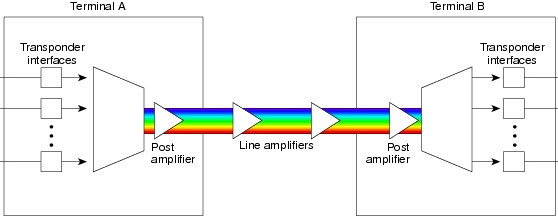The evolution of dense wavelength-division multiplexing (DWDM) systems is going on with an explosion in traffic and an increase in bandwidth-hungry applications for more multimedia services. Dense wavelength-division multiplexing, as an important technology in fiber optical network, is ideal for fiber optical-based solutions. By converting the operating wavelength of the incoming bitstream to an ITU-compliant wavelength, a wavelength-converting transponder serves as a key component in DWDM system. This publication mainly discusses wavelength-converting transponder in DWDM system.
A Wavelength-converting transponder is an element that sends and receives the optical signal from a fiber. It is an optical-electrical-optical (O-E-O) wavelength converter and performs an O-E-O operation. In DWDM system, the transponder takes the signal and transmits it in the C-Band through the use of a laser. More specifically, it receives the input optical signal, converts that signal into the electrical domain and re-transmits the signal by using a 1550nm band laser. An image of DWDM system with transponders is below.

Signal regeneration was not initially implemented in transponders. At first, these transponders were only used to convert the wavelengths of incoming external signals into wavelengths that worked with DWDM systems: namely, those in the C-Band. But now, this conversion also serves to stabilize the frequencies and amplify the power of these signals into something compatible with the erbium-doped fiber amplifiers (EDFA) in DWDM system. The sophistication of the signal regeneration components in transponders grew as they progressed from 1R to 3R.
- 1R
1R stands for retransmission. The earliest wavelength-converting transponders deployed it. As the name implies, 1R does not employ any methods to “clean up” the signal. The transponders are “garbage in garbage out” since their output is nearly an analogue “copy” of the received optical signal, with little signal cleanup occurring. This process happened regardless of signal integrity. More specifically, if the incoming optical signal was “junk”, the analog version of it would be “junk” as well. Another consequence of 1R is that the practical distance of DWDM systems is limited because of the potential signal degradation inherent to long-reach communications.
- 2R
2R means re-time and re-transmit. Before the incoming external signal is retransmitted, it first goes through a process to clean it up. Signal-quality monitoring is done at this point.
- 3R
3R represents re-time, re-transmit, and reshape. Signal quality can be monitored more closely and accurately in this advanced system as quality bits embedded in the signal are included, which tells the level of health and degradation of the signal for the system. The monitoring of bidirectional communication is possible in 3R systems.
Transponders in DWDM systems are utilized for various applications, including broadcasters and cable operations, data networks, and satellite and wireless communications. They can also support SFP, SFP+ and XFP transceivers with data rates up to 11.32 Gpbs. DWDM systems that are based on transponders can be implemented as a replacement for any existing WDM systems in view of cost advantage. Using these systems multiplies the capacity of the existing fiber by up to 10 or more times. Besides, the flexibility in the design of networks is also provided by these systems.
Wavelength-converting transponder is the key DWDM system component needed to facilitate signal transmission. Fiberstore WDM transponders, designed with high quality and high performance, ensure you high fiber bandwidth. Additionally, other WDM components, such as WDM Mux/Demux and OADM, are all available in Fiberstore. For more information about WDM and DWDM system components, please visit www.fs.com.